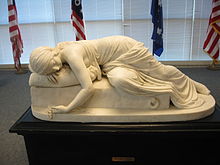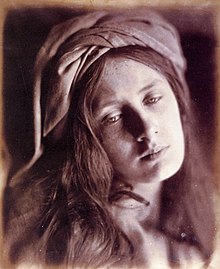Beatrice Cenci
This article includes a list of general references, but it lacks sufficient corresponding inline citations. (September 2021) |
Beatrice Cenci (Italian: [beaˈtriːtʃe ˈtʃɛntʃi]; 6 February 1577 – 11 September 1599)[2] was a Roman noblewoman imprisoned by her father, who repeatedly raped her. To escape the abuse and get away from the house, she killed him. The story of the murder and what led up to it shocked Europe. Despite outpourings of public sympathy, Beatrice Cenci was beheaded in 1599 after a lurid murder trial in Rome that gave rise to an enduring legend about her.[3]
Life
Beatrice was the daughter of Ersilia Santacroce and Count Francesco Cenci,[4] a "man of great wealth but dissolute habits and violent temper".[5] When Beatrice was seven years old, in June 1584, her mother died. After her mother's death, Beatrice and her elder sister Antonina were sent to a small monastery, Santa Croce a Montecitorio for Franciscan Tertiary nuns in the rione Colonna of Rome.[6]

The family lived in Rome at the Palazzo Cenci in the
According to legend, Francesco Cenci abused his first wife Ersilia Santa Croce and his sons and repeatedly raped Beatrice. He was jailed for other crimes, but was freed early because of his noble status.[3] Beatrice tried to inform the authorities about his abusive behaviour, but no effective action was taken.[3] When he found out that his daughter had reported him, he sent Beatrice and Lucrezia away from Rome to live in the family's castle at La Petrella del Salto.
The four Cencis decided they had no alternative but to try to get rid of Count Francesco, and together organized a plot. In 1598, during one of Francesco's stays at the castle, two

Eventually, his absence was noticed, and the papal police investigated. Beatrice's lover was tortured and died without revealing the truth. Meanwhile, a family friend who was aware of the murder ordered the killing of the second vassal to avoid any risk. Nonetheless, the plot was discovered, and the four members of the Cenci family were arrested, found guilty, and sentenced to death.The investigation into Francesco Cenci's death revealed key details, such as the involvement of Marzio Floriani and Olimpio Calvetti, and the initial attempt to stage the murder as an accident. This led to intense judicial scrutiny, including the torture and forced confessions of the accused under Pope Clement VIII's directive, highlighting the era's harsh judicial practices.[7]
Knowing the reasons for the murder, the common people of Rome protested against the tribunal's decision, obtaining a short postponement of the execution. Pope
At dawn on 11 September 1599, they were taken to
The legend
Beatrice has become a symbol to the people of Rome of resistance against the arrogant aristocracy. It is related that every year on the night before the anniversary of her death, she comes back to the Sant'Angelo Bridge where she was executed, carrying her severed head.[10]
Influence on literature and the arts

Beatrice Cenci has been the subject of a number of literary and musical works:
- Philip Massinger's play The Unnatural Combat (c.1619) contains specific echoes of the case and antedates the Romantic revival of Beatrice by 200 years
- Percy Bysshe Shelley's verse drama The Cenci: A Tragedy in Five Acts (composed at Rome and at Villa Valsovano near Livorno, May–5 August 1819, published spring 1820 by C. & J. Ollier, London, 1819)
- "Les Cenci", a short story by Stendhal (1837)
- Béatrix Cenci, a verse drama (1839), by Polish poet, Juliusz Słowacki
- Beatrice Cenci, a novel by Francesco Domenico Guerrazzi (1854)
- "Beatrice Cenci (In a City Shop-Window)" (1871), a poem by Sarah Morgan Bryan Piatt, American poet
- Béatrix Cenci, by Astolphe de Custine
- Nemesis, tragedy by Alfred Nobel
- Beatrice Cenci, a play by Alberto Moravia (1958), trans. Angus Davidson (1965))
- Beatriz Cenci, a verse drama by Gonçalves Dias
- Beatrix Cenci, opera by Alberto Ginastera, based on the Shelley play
- Beatrice Cenci, opera by Berthold Goldschmidt, based on the Shelley play
- Les Cenci (1935), play by Antonin Artaud, adaptation of the Shelley play
- The Cenci, essay by Alexandre Dumasin Volume 1 of Celebrated Crimes (1840)
- Legende und Wahrheit der Beatrice Cenci (1926), short story by Stefan Zweig
- The Cenci (1951–52), an opera by Havergal Brian (abridged from Shelley's play)
- radio play by Lizzie Hopley directed by Lu Kemp
- Beatrice Cenci (2006), musical drama by Alessandro Londei and Brunella Caronti
- Béatrice Cenci : Telle une fleur coupée, a novel by Jean Rocchi, editor Esmeralda (10 May 2004)
- "Finis the Cenci" (1954), a 17-line poem by F. R. Scott in Events and Signals; also in his Selected Poems (1966) and Collected Poems (1981)
- A Tale for Midnight (1955), a novel by Frederic Prokosch
- the Canadian opera Beatrice Chancy, written by George Elliott Clarke and James Rolfe (and inspired by the Shelley play), transplants the story to nineteenth-century Nova Scotia.
- 11 settembre 1599, A Beatrice Cenci , a piece in poetic prose by Sabrina Gatti (Italian writer), in Il trono dei poveri (2020)
- The "Big Finish Productions" "Doctor Who" audio drama Theatre of Cruelty, part of the Ninth Doctor box set Buried Threats, starring "Christopher Eccleston" (2024) is set around the story of Beatrice Cenci.
Statues, paintings, and photography also provide numerous portraits and homages to Beatice Cenci: The Italian painter Caravaggio witnessed Beatrice's public execution and may have used it as inspiration for the decapitation scene in his painting Judith Beheading Holofernes.[11]
A statue by American sculptor

The early photographer Julia Margaret Cameron posed her model, May Prinsep, as Beatrice in an 1866 albumen print portrait among a series she devoted to Beatrice Cenci.
The possible portrait of Beatrice Cenci by Baroque painter Guido Reni (1575–1642) and the legend surrounding Beatrice figure prominently in Nathaniel Hawthorne's The Marble Faun (1860). The book's two principal female characters, Hilda and Miriam, debate the nature and extent of Beatrice's guilt. Hilda believes Beatrice's act to be an "inexpiable crime" but Miriam believes it was "no sin at all, but the best possible virtue in the circumstances". Hawthorne draws many similarities between Miriam and Beatrice, and the reader must decide whether Miriam is an avenger or a culprit.
In Letitia Elizabeth Landon's short story "The Bride of Lindorf" (1836), the main character has an emotional attachment to the painting of Beatrice Cenci.
The Reni painting and the story of Beatrice figure in the plot of Liza Marklund's novel Last Will (2006). The painting also figures in Book 26 of Herman Melville's novel Pierre; or, The Ambiguities (1852).
In David Lynch's film Mulholland Dr. (2001), Reni's painting is shown hanging in the Hollywood apartment of Ruth Elms as a reference to Cenci.
The 1969 Italian film
The character played by Mia Farrow in the film Secret Ceremony is named Cenci, in reference to the Beatrice legend.
See also
Notes
Bibliography
- Chisholm, Hugh, ed. (1911). . Encyclopædia Britannica. Vol. 5 (11th ed.). Cambridge University Press. pp. 660–661.
- Guarazzi, Francesco Domenico. Beatrice Cenci (in Italian).
- Nicholl, Charles (2 July 1998). "Screaming in the Castle: The Case of Beatrice Cenci". London Review of Books. Vol. 20, no. 13.
References
- ^ a b Nicholl (1998).
- ^ "Beatrice Cenci | Italian noble". Encyclopædia Britannica. Retrieved 25 April 2019.
- ^ OCLC 1059033365.
- ^ "See C. Ricci in the entry "Cenci"". Encyclopedia Italiana. treccani.it. 1931. Retrieved 20 June 2017.
- ^ Chisholm (1911), p. 660.
- ^ Armellini, Mariano (1887). Le chiese di Roma Dalle loro origini sino al secolo XVI. Roma: Tipografia Editrice Romana. p. 214.
- ^ "The Story of Beatrice Cenci". Hotel Monte Cenci. Retrieved 16 January 2024.
- ^ a b Chisholm (1911), p. 661.
- ^ Bowyer, George; Farinaccius, Prosper (1838). A dissertation on the statutes of the cities of Italy; and a translation of the pleading of Prospero Farinacio in defence of Beatrice Cenci. Richards and Co.
- ISBN 9780199549344.
- ISBN 978-1-8759-8942-3.
- ^ Hotel Monte Cenci. "The Story of Beatrice Cenci". Paolo Mazzara. Retrieved 12 January 2024.
